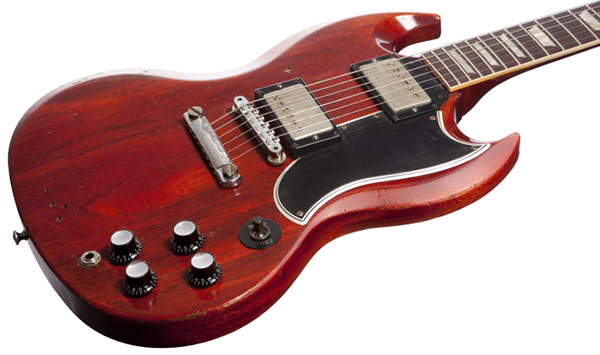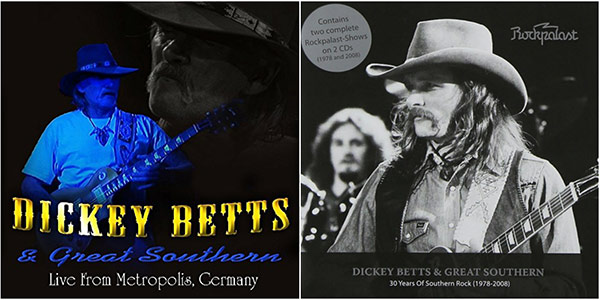In our ongoing series, Gibson.com salutes the careers of some lauded Gibson guitar greats. This time it’s the Allman Brothers’ often-underappreciated Dickey Betts, who turns 74 this week...

Who is he?
To the layman, he’s “the other guitarist” in the legendary Allman Brothers Band lineup, the one who isn’t Duane. To the knowledgeable, Forrest Richard “Dickey” Betts is not only an original member of the Allman Brothers Band but is also right up there with Duane as one of the most influential lead guitarists in rock. It’s true to say that Dickey Betts has rarely received a fair hearing; it’s also true that he’s sometimes made life difficult for himself. But when it comes to sheer musicality, the guy deserves acres of praise and hours of your listening time. 2017 has been a tragic year for Allmans fans, with the passing of Gregg Allman and Butch Trucks. Maybe it’s time Dickey Betts gets his props while he’s still with us.

Signature Sounds
Betts is a master of making his playing very simple, and the joyous melodicism of classic Allmans soloing has a lot to do with Betts. Away from Duane Allman’s stellar slide playing, Betts gives classic Allmans a kick of country and jazz, blended with his own take on blues motifs. He relies a lot on the simple major pentatonic scale, a staple in the bluegrass and country music he grew up on. In addition, he often reduces his runs to “cells” of four-or-so notes, played as up-or-down runs. This isn’t hard in theory, but playing this way repetitively with nuance and flavor is. Listen to Allman Brothers favorites like “Jessica”, “Melissa”, “Ramblin’ Man”, “In Memory of Elizabeth Reed” or “Blue Sky” as prime examples. It’s very hard to play simple scale-based solos and not them make them sound, well, “scaley” - like by-rote exercises. Betts can do it like a champ, though.
Betts’ inherent melodicism is key to why his playing is so distinct. Of his own composition “Jessica” he told Guitar World, “My instrumentals try to create some of the basic feelings of human interaction, like anger and joy and love.” With “Jessica,” it was the latter – Betts wrote it trying to capture the feeling of seeing his infant daughter crawling around the room. Of course, it’s not quite that simple. “I came up with that melody using just two fingers as a sort of tribute to Django [Reinhardt],” said Betts. “That the song turned out so well is very satisfying. In general, writing a good instrumental is very fulfilling because you’ve transcended language and spoken to someone with a melody.” Amen, brother!
He introduces flattened notes into the five-note pentatonic as well, of course, adding the minor third or the perfect fourth (you end up with a somehow unfavorable-sounding “hexatonic scale”), passing notes, slurs... but it’s easy to get bogged down in the theory of it all. What is undeniable is that he blended with Duane Allman like one of the great (est?) guitar partnerships. “We didn’t do it consciously,” Betts told Gibson.com. “We knew that when we started improvising, things fit, and we didn’t analyze it. Duane was more real militaristic in to urban blues. And then I had a Western swing lilt to my rock playing and it fit together beautifully.”
Betts’ tone was also legendary of those early Allmans records. His search for tonal heaven – usually on his Gibson Les Pauls or SGs – was inspired by an unlikely source. “I guess it goes back to when I was a kid,” he told Gibson.com. “I saw how my dad would pay attention to his fiddle sound. He knew how to tune a fiddle by putting a tone post in, to push the top of the fiddle up. He would move that post around until he had just the right tone. So I think that search for tone is just in my disposition. I always wanted my guitar to have a little edge on it, but with a clear sound. I experimented with different speaker combinations until I found it. Part of your tone is in your hand, too.”
We could go on and on... but Betts deserves more than a listen as just “the other” guitarist in the Allmans’ mighty catalog. As the late Duane even acknowledged, “I’m the famous guitar player... but Dickey is the good one.” Betts’ clean-toned, modal-style soloing lives on in every Southern rock group that’s followed.

Dickey Betts and Gibson Guitars
For the classic Allmans albums, Betts relied on Gibson Les Pauls and SGs, and many have become as famous as their owners. Over the years Gibson Custom has recreated the replica “From One Brother To Another” 61/62 Gibson SG that Betts gave to Duane for slide playing. They also replicated his 1957 “Goldie” Goldtop. Both were limited editions and are collectors’ items now. As Betts said of the recreations, “Gibson did such a great job making that guitar” (of the SG), and “I think I might actually like it more than Goldie now” (of the Goldtop). Then there’s the Dickey Betts ‘57 Redtop Les Paul, the Goldtop that got so oxidized Betts stripped it down to bare wood and refinished it. That one was immortalized in 1975 when Charlie Daniels sang about “Richard Betts picking that red guitar” in his tribute to Southern rock, “The South’s Gonna Do It Again.”

Essential Listening
If you really must listen to only one, the Allman Brothers Band’s Live At Fillmore East is fabled for good reason; even Betts recommends it. “Fillmore East is truly a live album,” he told Gibson. “There is nothing redone on that. Not like some live records… where the only thing live on there is the audience. Duane and me really respected one another. We didn’t hot dog or play over each other.” In Eat A Peach – on which Duane tragically didn’t get to play on everything – shines a light on Betts’ own immense talent, as does the Duane-less Brothers & Sisters. Betts own Dickey Betts & Great Southern and Atlanta’s Burning Down from the late ‘70s are also highly recommended for superbly slippery guitar. His solo debut of 1974, Highway Call, was (understandably, given its post-Duane era) a more downbeat songwriter-type affair. These are tips for newbies only: if you’re an Allmans and Betts aficionado, you’ll already have dug way deeper.
Watch!
The Allmans organization has its own official YouTube channel. Here’s the Allman Brothers Band in 1982 at a free show at the University Of Florida, and it’s outside so you can actually see how Dickey Betts plays. It’s a good study.






